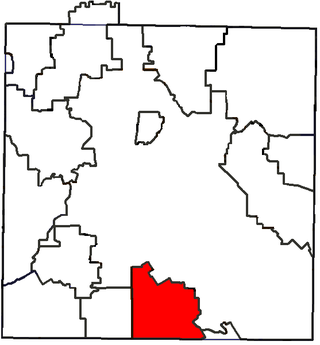Palos Verdes Peninsula Unified School District (PVPUSD) is a school district headquartered in Palos Verdes Estates, California with facilities in all four cities of the Palos Verdes Peninsula.
Toms River Regional Schools is a comprehensive regional public school district primarily located in the quickly growing coastal community of Toms River, located in Ocean County, in the U.S. state of New Jersey, along the state's Jersey Shore. The district includes Toms River and the adjoining boroughs of Beachwood, Pine Beach and South Toms River. It is the largest suburban school district in the state, and the fourth largest school district in New Jersey. It is also the largest school district in the state that is not an Abbott District.
The Bordentown Regional School District is a comprehensive regional public school district that serves students in pre-Kindergarten through twelfth grade from communities in Burlington County, in the U.S. state of New Jersey. The district serves students from Bordentown City, Bordentown Township and Fieldsboro Borough.
The Cinnaminson Township Public Schools is a comprehensive community public school district that serves students in pre-kindergarten through twelfth grade from Cinnaminson Township, in Burlington County, in the U.S. state of New Jersey.
The Edison Township Public Schools is a comprehensive community public school district, serving students in pre-kindergarten through twelfth grade from Edison, in Middlesex County, in the U.S. state of New Jersey. The school district has two preschools, 11 elementary schools, four middle schools and two high schools that are part of the district, serving a culturally diverse student population.

The Ramsey Public School District is a comprehensive community public school district that serves students in pre-kindergarten through twelfth grade from Ramsey in Bergen County, in the U.S. state of New Jersey.

Lancaster Independent School District is a public school district based in Lancaster, Texas (US). The district serves most of the city of Lancaster, a small portion of Dallas, and a small portion of the city of Hutchins.
The Delran Township School District is a comprehensive community public school district that serves students in pre-kindergarten through twelfth grade from Delran Township, in Burlington County, in the U.S. state of New Jersey.
Willingboro Public Schools is a comprehensive community public school district that serves students in pre-kindergarten through twelfth grade from Willingboro Township, in Burlington County, in the U.S. state of New Jersey.
The Pennsauken Public Schools are a comprehensive community public school district serving students in pre-kindergarten through twelfth grade from Pennsauken Township, in Camden County, in the U.S. state of New Jersey.

Garnet Valley School District (GVSD) is a public school district based in Glen Mills, Pennsylvania, within the Greater Philadelphia area. GVSD serves the town of Chester Heights, Bethel Township and Concord Township. Founded in 1959, it is one of the youngest school districts in Pennsylvania. Garnet Valley is one of the leading school districts, competing academically and athletically amongst the top decile schools in the state. The district is run by a school board consisting of nine elected, unpaid members. In addition to the school board, the student body of Garnet Valley High School elects two student representatives for a one-year term that runs concurrent with the fiscal year. These representatives serve in a non-voting advisory capacity.
The Glassboro Public Schools are a comprehensive community public school district that serves students in pre-kindergarten through twelfth grade from Glassboro, in Gloucester County, in the U.S. state of New Jersey.

The Durham Public Schools district is a public school district in Durham, North Carolina. Formed in 1992 with the merger of Durham's previous two school districts, it is 8th largest school system in North Carolina as of November 2020. There are 55 public schools in the system, consisting of 31 elementary (K-5), 9 middle (6-8), 2 secondary (6-12), 11 high (9-12), 1 alternative, 1 hospital school, and 1 virtual academy (K-12). Durham's schools are traditionally named after notable members of the local community.
The Wall Township Public Schools are a comprehensive community public school district that serves students in pre-kindergarten through twelfth grade from Wall Township, in Monmouth County, in the U.S. state of New Jersey.
The Manville School District is a comprehensive community public school district that serves students in pre-kindergarten through twelfth grade from Manville in Somerset County, in the U.S. state of New Jersey.
Spotsylvania County Public Schools is a public school district serving Spotsylvania County, Virginia. It consists of 17 Elementary, 7 Middle, and 5 High Schools and has a total enrollment of nearly 24,000 students. The Spotsylvania County School division also has a Career and Technical Center and participates with other local school systems to offer the Commonwealth Governor's School. The district partners with area businesses to develop learning opportunities for the students. Spotsylvania County Public Schools works with the area Parks and Recreation Department to help maintain the area around the Schools.

The Oxford School District is a public school district based in Oxford, Mississippi.
The Minisink Valley Central School District is a unified school district in Orange County, New York. The district consists of five schools; an elementary, intermediate, middle, and high school, which are all located in the township of Wawayanda, New York and the Otisville Elementary school, located in the village of the same name. Although one of the last school districts to formulate in New York, Minisink boasts one of the largest campuses in the state, with its buildings, sports fields, and facilities covering 145 acres (0.59 km2) in the western Hudson Valley. The enrollment of the five schools comprises approximately 4,700 students from the surrounding towns and hamlets of Minisink, Greenville, Wawayanda, New Hampton, Mt. Hope, Mamakating and Wallkill. The school gets its name from the valley for which it is located. Its school mascot is the Minisink Warrior.
The Woodbine School District is a community public school district that serves students in pre-kindergarten through eighth grade from Woodbine, in Cape May County, in the U.S. state of New Jersey.
The Saratoga Springs City School District is the public school district of Saratoga Springs, New York. The district is an independent public entity. It is governed by the Saratoga Springs City School District Board of Education, whose members are elected in non-partisan elections for staggered, three-year terms. The board selects a superintendent, who is the district's chief administrative official. The district's offices are located in the former Junior High building on 3 Blue Streak Boulevard, next to the high school.






